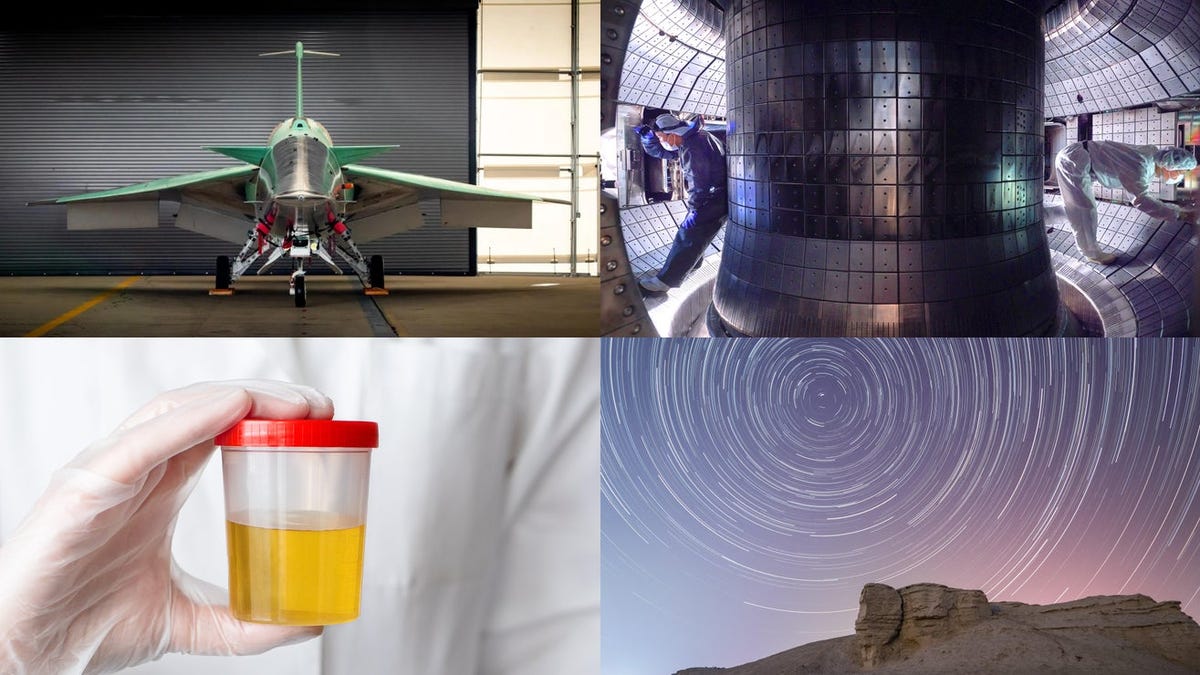We’ll Get to See NASA’s Sonic Boom-Less Supersonic Plane Next Week
Astronomers Could Soon Get Warnings When SpaceX Satellites Threaten Their View
NASA’s supersonic experimental plane—the linchpin of the agency’s Quesst mission—is set to roll out of its warehouse in the California desert next week. We’re gassed for the big moment: the X-59 has been in development for six years, and, if successful, it will demonstrate supersonic flight without sonic booms. – Isaac Schultz Read More
South Korea’s Artificial Sun Is Cooking 100-Million-Degree Plasma
Workers inside the vacuum vessel of the KSTAR tokamak.Photo: Korea Institute of Fusion Energy (KFE)
The Korea Institute of Fusion Energy has installed a new diverter in the KSTAR tokamak, allowing the artificial sun to sustain high-ion temperatures exceeding 100 million degrees Celsius for longer. – Isaac Schultz Read More
Urine Luck Because Scientists Figured Out Why Pee Is Yellow
Image: shi-olga (Shutterstock)
Scientists say they’ve finally answered an age-old question: Just why is our pee yellow? In new research, a team found the enzyme produced by gut bacteria that plays a major role in turning our urine mellow. Curiosity aside, the discovery may actually help scientists better understand the gut microbiome and how it can contribute to certain health conditions, like jaundice in newborns. – Ed Cara Read More
The Quadrantids: How to See Hundreds of Shooting Stars Tonight
A Quadrantid meteor shower as seen over the Xinjiang Uygur Autonomous Region in January 2022.Photo: Xue Bing / Costfoto/Future Publishing (Getty Images)
Meteor lovers, rejoice. The year’s first big shower is upon us. Here’s everything you need to know if you want to catch a glimpse of these fireballs.
Situated between the constellations Bootes and Draco (right near the Big Dipper), the Quadrantids are named for Quadrans Muralis, a now-defunct constellation. They are an annual shower that peaks in early January, and they are, in my meteor-loving opinion, a great way to kick off each new year. – Isaac Schultz Read More
ULA’s Vulcan Centaur Rocket Set to Launch Monday, a Challenge to SpaceX
The Vulcan rocket booster and second stage during tests in Florida.Photo: ULA
On Monday, January 8, United Launch Alliance’s Vulcan Centaur could finally perform its first flight. ULA has been a rock in the spaceflight industry since its founding in 2006, and with this pending launch, the company is ready to take its next bold step into space. Here’s what you should know about America’s latest powerhouse rocket and and how it could disrupt the sector and compete with the ever-dominant SpaceX. – George Dvorsky Read More
See Wild New Close-Up Images of Jupiter’s Volcanic Moon Io
NASA’s Juno mission captured Jupiter’s moon Io on December 30 during its closest flyby. Image: NASA/Image processed by Kevin M. Gill
The mutilated surface of Jupiter’s moon Io was revealed in great detail by the Juno spacecraft, which has been exploring the Jovian system since 2016 and recently pulled off the closest flyby of the volcanic world. – Passant Rabie Read More
SpaceX’s Latest Launch Will Bring Starlink to T-Mobile Phones
The latest batch of Starlink satellites included six direct to cell satellites.Photo: SpaceX
SpaceX is gearing up to test its Starlink satellites’ ability to connect directly to cellphones in the U.S., launching the first six satellites under a temporary license with the hopes to expand its connectivity reach beyond that of traditional cell signals. – Passant Rabie Read More
NASA’s OSIRIS-APEX Brushes the Sun on Its Way to New Asteroid Target
An artist’s depiction of the spacecraft on the surface of Apophis.Illustration: NASA’s Goddard Space Flight Center Conceptual Image Lab
New mission, who dis? The spacecraft formerly known as OSIRIS-REx had an impromptu close encounter with the Sun as it follows a newly crafted route to a second asteroid, using one of its solar arrays for shade. – Passant Rabie Read More
1.75-Billion-Year-Old Fossils Are Oldest Record of Oxygenic Photosynthesis
The story of life on Earth can’t be told without photosynthesis, the process by which plants (and some other lifeforms) convert sunlight into chemical energy. Now, a team of researchers has announced the discovery of fossilized photosynthetic structures—the oldest yet known—from a staggering 1.75 billion years ago. – Isaac Schultz Read More
Scientists Lightly Zapped People’s Brains and Made Them Easier to Hypnotize
Image: Brian A Jackson (Shutterstock)
Researchers at Stanford University say they’ve made the sort of discovery that you’d expect to see in a piece of science fiction. In a controlled and randomized trial published this week, they found evidence that people can be made more susceptible to hypnosis with just two short sessions of non-invasive brain stimulation. The findings suggest that brain stimulation could make hypnosis a more effective treatment for various health conditions like chronic pain, though more extensive research will be needed to know for sure. – Ed Cara Read More
